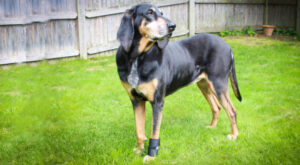On occasion, dogs do things that make you question their behavior. For instance, you may ask, “why does my dog kick his back legs randomly?” As you know, dog’s can’t talk! They can’t articulate their emotions, so we have to determine what they’re thinking and feeling by reading their body language.
Your dog may randomly kick his back legs due to a number of reasons:
-
- scratch reflex
- excitement
- REM sleep
- muscle spasm
- nerve damage
-
- hip dysplasia
- medial patellar luxation
- degenerative joint disease
- marking their territory
Want to learn more about why your dog kicks his back legs randomly? Read on!
Other articles you would like: Why Does My Dog Scratch The Carpet and How To Stop Your Dog From Scratching The Door.
Why Does My Dog Kick His Back Legs Randomly?
When your dog kicks out his hind legs, it may be expected behavior. However, in some cases it may be indicative of a more severe problem. Take note of whether your dog is eating, drinking, and otherwise acting normally. If not, it may be time to see a vet.
While your dog kicking out hind legs may be expected, it could indicate a more severe problem. However, if your pup is feeding, drinking, and acting normally, they are generally safe, but you should still have them examined by a vet.
Several of the most prevalent reasons you’ll observe your canine companion kicking his back legs include:
Defining Their Territory
There are scent glands in the back of your dog’s feet, so kicking is an attempt to spread their scent when they kick. Dominant canine pets tend to do this to caution other dogs to avoid getting close to them.
On the other hand, submissive pets use this technique to communicate that they are present but not a threat to other dogs. Either way, it is an indicator of their presence.
Degenerative Joint Disease
Degenerative joint disease occurs when soft cartilage that shields and covers the ends of bones and stiff joints deteriorates. The joint disease is more prevalent in dogs born with defective joints or those who have already had a joint injury.
Symptoms will vary according to your pet’s age, the intensity of the illness, and the damaged joint. Depending on your dog’s pain intensity, the first visible symptom will be a change in gait, a drop in muscle size, loss of appetite, and changed behavior.
Leg stiffness and hesitation in making certain motions could all be signs of degenerative joint disease, as are an increase in sleep and weight gain. Certain dogs will also tend to lick and bite the affected area.
While the degenerative joint disease is challenging to prevent, it can be mitigated if detected, diagnosed, and treated appropriately (and as soon as possible) by your veterinarian. Ensure that you maintain your dog’s fitness level while discouraging them from jumping from heights or engaging in other potentially dangerous habits.
Additionally, provide ample water and carefully massage the afflicted area under the direction of your vet. You can achieve pain relief through the use of heat and cold therapy. Provide a supportive and balanced diet for your pet that will enhance their muscular systems while avoiding overworking them to prevent the disease from recurring.
Excitement
Why does my dog kick his back legs randomly? Well, he may just be excited! Dogs demonstrate their happiness in various ways, and one of these is kicking their back legs as if their satisfaction is driving them.
To be sure that this is the case, make a conscious effort to become aware of when they kick their back legs. Do they begin to kick their back legs when you give them treats? Or when you’re packing up their toys?
Sometimes, when your pawed buddy kicks their back legs, it is just a way to express their excitement and shouldn’t be cause for alarm.
Scratch Reflex
It is also possible your dog kicking back legs like bull is reflexive. It’s the same sensation as when petting your pup, and they kick you abruptly. This involuntary reaction is referred to as scratch reflex, which is a term that refers to your dog’s response to being stroked – it’s beyond their control.
Many nerves run under your dog’s skin, which is also the dog’s sweet spot. ‘
Assume you’re caressing or stroking your dog’s tummy; if you touch the ‘sweet spot,’ your dog will immediately react.
A message will be conveyed from the nerves to the spinal cord, which travels directly to his back legs rather than the dog’s head. As a result, the legs kick unintentionally in response.
If it is a sensitive area, your pet may not appreciate you touching them constantly. However, an occasional scratch is likely to be delightful. If your dog appears to be itching, it may be ill or have a skin disease. Itchy dogs are more susceptible to fleas, resulting in serious health concerns.
Rapid Eye Movement
Does your dog doze off then begin to kick his legs randomly? You may be concerned about why this occurs.
If you also notice them breathing rapidly or wiggling their paws when they’re sleeping, accompanied by grunts and sometimes even groaning, the culprit is most likely rapid eye movement (REM) sleep.
REM is a period of sleep during which the brain maintains the same activity level while awake. The phenomenon is present in both human beings and pets. For instance, when humans sleep walk or sleep talk, this is during REM sleep.
Your canine buddy may be more affected if they play a lot during the daytime, as they will almost certainly dream when it is time to sleep.
As the owner, you may do various things to assist your dog is sleeping comfortably and avoiding REM cycle troubles.
These include:
- adding a nightlight
- inspecting your home for any nocturnal animals living in the walls
- adding white noise for pets that have a hard time falling asleep
- ensuring that the temperature is conducive
- evaluating your dog’s life for possible sources of anxiety
- contacting your veterinarian
Muscle Spasms
Muscle spasms, also referred to as muscle cramps, refer to the muscles’ fast and reflexive tremors. This occurs regularly when your dog engages in strenuous physical activity. As a result, muscle contractions are interrupted, and your pet’s muscles will spasm.
When your furry friend kicks their legs, they are in spasm. Regularly, it may manifest as jerking or twitching. You can ascertain it by feeling your pawed friends’ legs. The body senses muscle spasms as vibrations.
Muscle spasms are pretty painful, particularly when they last an extended period.
The easiest way to reduce muscle spasms induced by excessive exertion is to ensure your pup stays hydrated. Additionally, assist them in warming up and cooling down before and after strenuous exercise sessions. Ask your vet if any special dietary considerations should be made, too.
Nerve Damage
If you’re asking, “why does my dog kick his back legs randomly,” consider your dog’s recent injuries. Nerve injury impairs message transmission to the head. It may delay the signal or redirect it to another body part.
For instance, if the nerves in a dog’s lower body are impacted, there will be an issue with the present nerves. They will be unable to communicate with the brain due to their inability to receive or transmit messages. The result will be that the nerves will send the message instantly to the pup’s legs.
Hip Dysplasia
Hip dysplasia is a common condition in large dogs in which the joint grows abnormally.
Hip dysplasia is caused by the following:
- genetics
- undernourishment
- excessive growth
- inadequate physical activity
As a result of this ailment, your dog will experience excruciating pain. As they walk, you may notice him limping. He will also kick his legs as the discomfort increases. Bring your dog to the vet if you notice any of these symptoms – surgery may be required.
Medial Patellar Luxation
Your furry friend may kick his back legs randomly because of medial patellar luxation. Or, as it is more frequently referred to, displacement of a pup’s kneecap.
Since dogs rarely exhibit signs of discomfort, it can be challenging to identify medial patellar luxation. The condition may cause your dogs to kick to the back or side – this action enables them to stretch their knees. When they stretch, the kneecap adjusts to its correct position. Dogs also tend to kick to alleviate discomfort caused by patellar luxation.
Note that kneecap dislocations are more common in small toy breeds.
Although medial patellar luxation can occur in all dogs, it is more prevalent in small breeds like chihuahuas and Boston terriers. One or both of your dog’s back legs may be affected, and the problem may have been caused by injury. The condition is most common in dogs with short femoral grooves.
The severity of the condition will dictate the degree of the symptoms. Affected dogs usually skip or keep their affected limb up for a few paces, shaking or spreading the leg out. As the ailment advances, the severity of lameness may rise.
Bowleggedness is a frequent symptom of this illness in puppies, and it worsens with age. As the knee moves more frequently out of place, the cartilage deteriorates, and the bone becomes exposed, resulting in arthritis and pain.
Seizures
When dogs suffer a seizure, they may kick their legs; this is a common symptom of abnormal brain activity. A seizure causes a dog to exhibit extreme shaking as well as contractions. Their limbs and muscles are usually particularly vulnerable. The involuntary motions your dog makes while he is seizing may make it look like your dog is kicking his legs.
When a dog experiences a seizure, you may notice that your dog is:
- perplexed
- concerned
- exhausted
- terrified
- delusional
Conclusion For Why Does My Dog Kick His Back Legs Randomly?
From time to time, you may notice that your dog kicks his back legs randomly. The only way to ensure that your dog is safe is with a visit to the vet! You may be able to mitigate discomfort from your own home, but a vet can check for underlying causes of the symptom and help you as you make your dog comfortable.
Other articles you would like:
Still curious why your dog kicks his back legs randomly? Check out this video:
Garrett loves animals and is a huge advocate for all Doodle dog breeds. He owns his own Goldendoodle named Kona. In addition, he volunteers at the Humane Society of Silicon Valley, where he fosters dogs and helps animals. Garrett enjoys writing about Doodles and believes that dogs can teach humans more about how to live than humans can teach a dog.
Why Trust We Love Doodles?
At We Love Doodles, we’re a team of writers, veterinarians, and puppy trainers that love dogs. Our team of qualified experts researches and provides reliable information on a wide range of dog topics. Our reviews are based on customer feedback, hands-on testing, and in-depth analysis. We are fully transparent and honest to our community of dog owners and future owners.











